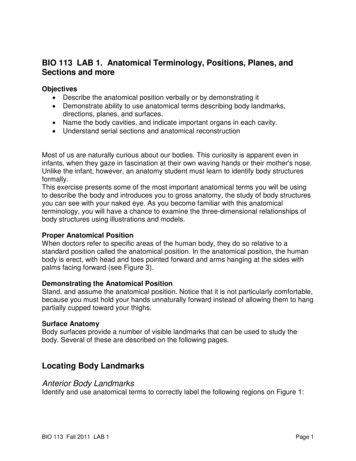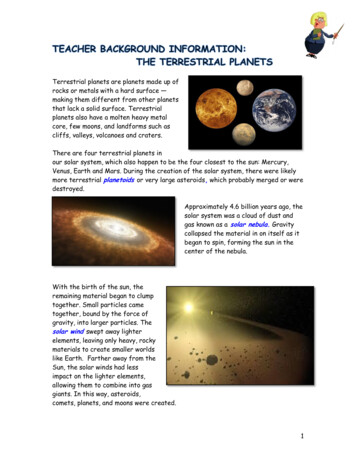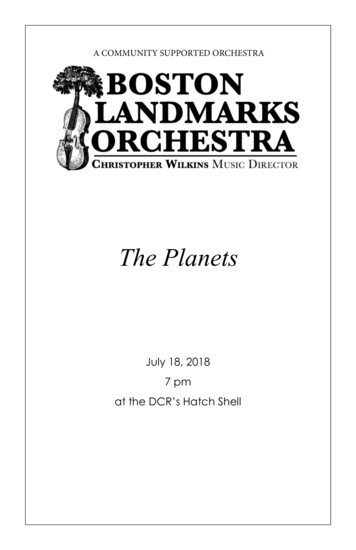
Transcription
A COMMUNITY SUPPORTED ORCHESTRAThe PlanetsJuly 18, 20187 pmat the DCR’s Hatch Shell
Boston Landmarks OrchestraVIOLIN IGregory Vitale, concertmasterChristine VitalePattison StoryRebecca KatsenasColin DavisTera GorsettStacey AldenJessica AmidonFLUTELisa Hennessy, principalTeresa PattonFLUTE/PICCOLOIva MilchTRUMPETDana Oakes, principalJesse LevineGreg WhitakerBruce HallFLUTE/PICCOLO/ALTO FLUTEKathleen BoydVIOLIN IIPaula Oakes, principalSusan JensenMaynard GoldmanAsaka UsuiRobert CurtisOlga KouznetsovaOBOEAndrew Price, principalLynda JacquinTROMBONERobert Couture, principalHans BohnDonald RobinsonVIOLAKenneth Stalberg, principalAbigail CrossDonna JeromeDon KrishnaswamiNoriko FutagamiAshleigh GordonCELLOPatrick Owen, principalMelanie DyballJolene KesslerEugene KimDarry DolezalBASSRobert Lynam, principalBarry BoettgerKevin GreenJohn ShiuTUBADonald Rankin, principalOBOE/BASS OBOEBenjamin FoxTENOR TUBATakatsugu HagiwaraENGLISH HORNJennifer SlowikHARPHyunjung Choi, principalAmanda RomanoCLARINETSteven Jackson, principalMargo McGowanJan HalloranBASS CLARINETRyan YuréBASSOONMichael Mechanic, principalKatherine McWilliamsElah GrandelCONTRABASSOONSusannah TelseyHORNKevin Owen,principalJane SebringWhitacre HillNancy HudginsRobert MarlattKate GascoigneCELESTE/ORGANVytas BaksysTIMPANIJeffrey Fischer, principalCraig McNuttPERCUSSIONRobert Schulz, principalGregory SimondsAaron TrantJonathan HessMaynard Goldman,Personnel ManagerAmerican Sign Language(ASL) TeamAdrianna NeefusChristopher RobinsonKelly KimPaulina Voices of St. Paul’s Girls’ SchoolMaya BanerjeeRuk BelangerAlice BruZelda Cahill-PattenHortense ComonIsmay ForsythOttilie Fox-CockettZUMIXAnna HaestrupElinor HarrisTasie JonesGabby KatzarosEmily KerriganElise LaneSusie PetriTara ShutesMatilda SidelAstrid StirlingElla SulzbergerRasnika WasanCaroline ZeghibeComposers: Tayler Fernandez Núñez, (vocals, keyboard) Rehanna Fernandez Núñez(spoken word, keyboard), Jennifer Perez (guitar, vocals), Eleasah Whittaker (piano)Percussionists: Amanda Legere, Angela Joya, Jader Anderson Contreras, JeffreyHernandez, Kaylene Sheran, Natalie Palencia, Nicolas Benjamin, Mateo Martinez,Andrew Claflin, Nickollas Lima
The PlanetsBoston Landmarks OrchestraChristopher Wilkins, Music DirectorPaulina Voices of St. Paul’s Girls’ SchoolLeigh O'Hara, Assistant Head, Director of Partnerships and Director of MusicHeidi Pegler, Deputy Director of Music and Head of SingingZUMIXPomp and Circumstance No. 1Edward Elgar(1857-1934)Clair de luneClaude Debussy(1862-1915)orch. André CapletFestive AlleluiaLyn Williams(b. 1963)Paulina Voices of St. Paul’s Girls’ SchoolTayler Fernandez NúñezRehanna Fernandez NúñezJennifer Perez, Eleasah WhittakerComposition guidance and orchestration byGonzalo GrauPegasus Promenade (world premiere)(b. 1972)ZUMIXPaulina Voices of St. Paul’s Girls’ SchoolINTERMISSIONGustav HolstThe Planets(1874-1934)Mars, the Bringer of WarVenus, the Bringer of PeaceMercury, the Winged MessengerJupiter, the Bringer of JollitySaturn, the Bringer of Old AgeUranus, the MagicianNeptune, the MysticPaulina Voices of St. Paul’s Girls’ School
The BOSTON LANDMARKS ORCHESTRA performs free outdoor concertsin the City of Boston throughout the summer, delighting thousands on aweekly basis. The Orchestra—made up of some of Boston’s mostaccomplished professional musicians—uses great symphonic music as ameans of gathering together people of all backgrounds and ages in joyfulcollaboration. The Orchestra regularly collaborates with a range of culturaland social service organizations to ensure participation across ethnic,economic, and cultural divides.The Boston Landmarks Orchestra is committed to BREAKING DOWNBARRIERS to access for people with disabilities. It offers braille, large-print,and text-to-speech programs, assisted listening devices, and ambassadors togreet and assist people at a handicapped drop-off point. The Orchestra workswith American Sign Language (ASL) interpreters as performers at selectconcerts. Rather than providing direct translation of the spoken word,interpreters communicate the feeling of the music and the remarks given duringthe concert.CHRISTOPHER WILKINS was appointed Music Director of the BostonLandmarks Orchestra in the spring of 2011. Since then he has reaffirmedfounder Charles Ansbacher’s vision of making great music accessible to thewhole community, emphasizing inclusive programming and collaborativework. Mr. Wilkins also serves as Music Director of the Akron Symphony.As a guest conductor, he has appeared with many of the leading orchestras ofthe United States, including those of Chicago, Cincinnati, Cleveland, Dallas,Detroit, Houston, Indianapolis, Los Angeles, Pittsburgh, and San Francisco.He has also appeared regularly with orchestras in New Zealand, LatinAmerica, Spain and the UK. Previously he served as Music Director of the SanAntonio Symphony and the Colorado Springs Symphony. He also served asResident Conductor of the Youth Orchestra of the Americas, assisting in theformation of the orchestra in its inaugural season, and leading it on toursthroughout the Americas. Born in Boston, Mr. Wilkins earned his bachelor'sdegree from Harvard College in 1978 and his master’s from the Yale School ofMusic in 1981. As an oboist, he performed with many ensembles in theBoston area including the Tanglewood Music Center, and the BostonPhilharmonic under Benjamin Zander.As one of the UK's leading independent day schools, ST. PAUL'S GIRLS'SCHOOL in London is a thriving community. Aspirations and achievements inmany areas go well beyond what one would normally expect from a school,making St. Paul's a very exciting and stimulating place in which to learn andwork. It was with such high ambitions for music that Frances Gray, the first HighMistress, appointed the distinguished composer, Gustav Holst, as the school'sfirst director of music in 1905. He was to remain in post until his death in 1934and most of his greatest works, including The Planets, were written during thistime. Following Holst, the school has been fortunate in having a succession ofdistinguished musicians (whether a composer or conductor) to lead thedepartment, including Ralph Vaughan Williams, Herbert Howells, John Gardnerand Julian Grant.
Pupils of all levels and abilities are encouraged to participate in extracurricularmusical activities and a very high proportion of the girls take individual musiclessons. There are two orchestras, a string orchestra, several wind ensembles,five choirs, close harmony groups and many small chamber ensembles. Pupilsfrom the school are regularly represented at the highest levels in the NationalYouth Orchestra, the London Schools' Symphony Orchestra, The NationalChildren's Orchestra and the National Youth Choir of Great Britain. A number ofpupils also study at the junior departments of the London music conservatoires.Paulina Voices is an auditioned choir for girls aged between 14-18 years old.We are delighted to be able to join with the Landmarks Orchestra and are verygrateful to our sponsors including Cecilia Chan and Ron Zeghibe for thisopportunity.LEIGH O'HARA, Assistant Head, Director of Partnerships and Director ofMusic at St. Paul’s Girls’ School, is known for his engaging and ambitiousperformances of major works with orchestras and choirs of non-professionalmusicians of all ages. After many years working as a pianist his career is nowfocused on conducting and his roles at St. Paul's Girls' School where he runs abusy department of almost 60 staff and an annual programme of about 60concerts. Having completed a music degree at the University of York, Leighcontinued his piano studies at Trinity College of Music before completing amasters degree at Royal Holloway, University of London. Leigh has beenresident at Dartington International Summer School, where he is a trustee, invarious capacities for over 20 years.HEIDI PEGLER, Deputy Director of Music and Head of Singing at St. Paul’sGirls’ School, studied at the Royal Welsh College of Music and Drama andTrinity College of Music, London. A specialist in Baroque music, she hasperformed at many of the UK's leading venues including the Royal Albert Hall,St. David's Hall and Glasgow Royal Concert Hall. Heidi has taught at St. Paul'sGirls' School for 20 years and steers a team of 10 singing teachers as well asconducting the choirs and directing musicals and operas. She has publishedseveral books including the award winning series The Language of Song(Faber), The Best of Singing (Faber) and It's never too late to sing (Faber).Heidi is a trainer and examiner for the Associated Board of the Royal Schoolsof Music and is the Chair of the Association of Teachers of Singing for 20182020.Boston Landmarks Orchestra would like to thank to Joe Rotondo and RonZeghibe for making this evening’s appearance by the St. Paul’s Girls’School Choir possible.Like a lot of good ideas, ZUMIX started in someone's living room. Co-FoundersBob Grove and current Executive Director Madeleine Steczynski foundedZUMIX in 1991 as a response to Boston’s worst wave of youth violence. Itbegan as a summer songwriting program with 24 youth, 200, and the simpleidea that giving youth something to be passionate about could transform livesand elevate communities. Its programming quickly expanded. In 1993 theycreated a free outdoor Summer Concert Series in order to serve the broadercommunity. Today, year-round events are organized to provide East Bostonresidents with access to top-quality arts and cultural events. ZUMIX serves over
500 youth per year through after-school and summer programming and 500through in-school partnerships. Over 10,000 additional adults, children, andfamilies attend its community events and festivals. Its mission is to empoweryouth who use music to make strong positive change in their lives, theircommunities, and the world. www.zumix.orgComposer, arranger, and multi-instrumentalist GONZALO GRAU began hismusical studies at the age of three in Caracas, Venezuela. Along his musicaljourney he developed skills in many instruments, from the viola da gamba andthe cello to the flamenco cajón and his principal instrument, the piano. ABerklee College of Music graduate, his credits include performances withVenezuelan music projects such as Maroa, Schola Cantorum de Venezuela,Camerata de Caracas and the Simón Bolivar National Youth Orchestra, jazzicon Maria Schneider and Latin jazz giant Timbalaye.As a music director he leads two projects of his own, "Plural" (Latin jazzFlamenco-Venezuelan fusion) and "La Clave Secreta" (salsa fusion),nominated for the 2008 Grammys in the Best Tropical Album category. As arecording artist, Grau has participated in over 80 productions that bridge bothclassical and popular music worlds. Wearing his composer and arranger hat,his achievements include composition collaborations alongside Osvaldo Golijovfor the opera Ainadamar and La Pasión Según San Marcos. He received theEuropean Composer Award in 2011, given by the Young Euro Classic Festivalin Berlin. His original works have been commissioned by the AtlantaSymphony, the Chicago Symphony, the Bach Academy International, and theBoston Landmarks Orchestra.Boston Landmarks Orchestra would like to thank The Plymouth RockFoundation for making this year’s collaboration with ZUMIX and GonzaloGrau possible.PODIUM NOTE:We are thrilled to welcome you to the eighteenth season of the BostonLandmarks Orchestra. This is the twelfth year that the orchestra has offered aregular series of free concerts at the Hatch Shell, and the ninetieth summer thatBostonians have gathered on the Esplanade to hear live orchestral music.Arthur Fiedler led the very first concert at the newly installed Music Oval in thesummer of 1929.Landmarks programming often explores the synergy of sight and sound. TheOrchestra’s name comes from the notion that the beauty of a venue canenhance a listener’s experience of the music, and vice versa. At the HatchShell, mesmerizing visual images appear everywhere: shifting shadows,crimson clouds, gliding sails, the lights of the city’s skyline, and, as eveningdescends, the growing teak-wood glow of the Shell. If you lie supine at ourconcerts—and most people at some point do—impressions of the skyaccompany the music. Tonight the music returns the favor, in a programreflecting the mysteries of the heavens.But first, we present ceremonial music to mark the opening of the new season.Edward Elgar dedicated each of the five original Pomp and Circumstance
marches to musical friends. The first—and best known of the five—wasdedicated to Alfred Rodewald and the Liverpool Orchestral Society. Themarch’s middle section boasts one of music’s immortal melodies. EveryAmerican knows it, even those who have no idea where it comes from. Elgarknew its worth the moment he conceived it: "I've got a tune that will knock'em—will knock 'em flat," he enthused to a friend. The Pomp and Circumstancemarches exude a deep British pride that wells up often in Elgar’s music,suggesting, as conductor Colin Davis put it, “nostalgia for a time that neverexisted.”Elgar’s celebratory march gives us the chance to offer a proper British welcometo the visiting choir of St. Paul’s Girls’ School of London, one of the mostadmired youth vocal ensembles in Europe. The school was Gustav Holst’smusical home for nearly 30 years, as he held the position of Director of Musicfrom 1905 until his death in 1934. The choir is currently on a US tour, led byDirector of Music Leigh O’Hara (Holst’s successor!) and Deputy Director ofMusic Heidi Pegler. Holst gave this choir—made up of his own students—afeatured role in the final movement of The Planets. We are thrilled to featurethe same ensemble in our own performance tonight, on the occasion of the100th anniversary of the premiere of The Planets. The girls are also featured—unaccompanied—in Festive Alleluia by Lyn Williams, one of Australia'sleading directors of youth choirs. The work is “a vibrant celebration of the soundand power of treble voices.”When we think of composers most able to summon nature’s power, ClaudeDebussy comes immediately to mind. His miniature masterpiece, Clair de lune(“Moonlight”), is the third movement of the Suite bergamasque for piano solo,inspired by a poem of Paul Verlaine. Tonight’s orchestration is by Debussy’sclose friend, André Caplet. The Frenchman Caplet was an accomplishedcomposer in his own right, and for a time he was also a Bostonian. From 1901–1904 he served as Music Director of the Boston Opera, located in the oldBoston Opera House on Huntington Avenue.The four-year partnership between the Landmarks Orchestra and ZUMIX inEast Boston has yielded some of the most compelling collaborations in ourhistory. Executive Director Madeleine Steczynski and Director of OperationsJenny Shulman lead a team that is deeply committed to making art atransformative force in young people’s lives. For the past three seasons, thesecollaborations have been captained by the Venezuelan-born composer,teacher, and performer Gonzalo Grau. Gonzalo’s artistic vision, hisexceptionally diverse skill set, and his profound compassion for people from allwalks of life have made him an ideal partner for us. My admiration has nobounds.Here, Gonzalo and the four young composer-performers from ZUMIX describethe work they have created together:Pegasus Promenade flowed from many sources. First, we were inspired byThe Planets, and by Gustav Holst’s insights into the human archetypes definedby astrology. I wanted to portray these personality types as if they were all in anexhibition, imagining we could observe each from a distance, then meet in acommon place a place I like to call “Cosmos.” Mussorgsky’s Pictures at an
Exhibition was my inspiration for this structure. Every time we return to thepromenade we are changed a bit, as we keep walking under the influence ofthe previous encounter.Pegasus Promenade expresses the romanticism of Aphrodite, the duality ofProteus, the protectiveness of Soteria, and the perfectionism and balance ofthe traveler Hermes. These ancient mythological characters represent a deepaspect of each of our young composers. - Gonzalo GrauWhen writing this piece, I took the basic elements that make up a Libra:balance, romance, and creativity. I wanted everyone to feel as if they werewalking on stars very happily. With the help of everyone offering ideas andcreating lyrics, I think we made it possible to imagine that you carry the galaxiesin the palm of your hand. - Jennifer PerezThis piece represents the Gemini's nature of being two distinct personalities.One is quick-witted, fun and expressive, while the other has a tendency to getserious, thoughtful and restless. These twins are expressed through twoinstruments with different frequencies to capture their contrast. Although thereare two contradictory elements, there is also a level of unison and harmony thatencompasses one distinct being, as if the body is a vessel for opposingthought. - Rehanna NúñezThe main motif of this movement is influenced by the ideas of comfort andwarmth associated with the Cancer zodiac sign. Along with it comes the themeof a youthful figure, which the Cancer feels the need to protect. - EleasahWhittakerThe final movement of Pegasus Promenade embodies the characteristics ofVirgo. The repetitive nature of the piano and the two different rhythms that worktogether cohesively is a representation of the Virgo tendency to belogical, perfect, and safe. With an additional layer of lyrics that explains howthere is an immense amount of pressure to be "perfect," it includes a level ofjuxtaposition to the rhythm, in which the Virgo character is trying to run awayfrom its own inevitable perfect nature in a precise tempo. - Tayler NúñezPEGASUS PROMENADE LyricsAPHRODITE(Jennifer Perez)Palms carry, Palms carry, IntertwiningPalms carry, Palms carry, GalaxiesGalaxies PROTEUS(Rehanna Núñez)Two halves bornIn different placesTheir souls create a dipoleIndecisive decisions constantly being madeThinking positively negative
Causes a headacheParting minds never really know where to goThey roam, search, exploreYet they always meetIn the middleSOTERIA(Eleasah Whittaker)[no lyrics]HERMES(Tayler Núñez)Aligned like, Aligned like, A constellationSpine carved like, Spine carved like, AtlasAligned like a constellation, Spine carved like AtlasAligned like, Aligned Aligned like a constellationSpine carved like, Spine AtlasA Constellation The music of Holst’s The Planets has been used to conjure images of Martiancanyons, crater-pocked moons of Uranus, Saturn’s multi-hued rings, andVenus’s murky clouds. It has evoked the serenity of the Morning Star, thegaseous blueness of Neptune, and the storm raging in Jupiter’s red eye. As asoundtrack it has accompanied spectacular images from the Cassinispacecraft, the space probes Galileo, Pioneer 10, Voyager 1 and 2, and theHubble Space Telescope.It would be hard to think any work of art—compared with Holst’s The Planets—which is so famously associated with something it has nothing to do with.Holst had a powerful set of images in mind while composing The Planets, butthey were not of the physical planets we know through modern astronomy orspace exploration, nor was he thinking primarily of the Roman gods who gavetheir names to the planets of our solar system. His inspiration came insteadfrom the planetary archetypes—concepts of form, energy, personality, andbehavior—associated with the planets since antiquity. Holst was concerned notwith outer space, but with inner space; with the psyche; and with essentialaspects of experience that are common to all human beings. In a word,astrology.I am deeply grateful to Richard Tarnas, author of a fascinating and groundbreaking book called Cosmos and Psyche, for his invaluable consultationswith me, and for allowing me to use some of his language in formulating my—actually, his and my—descriptions below.MarsHolst’s Suite begins with Mars. Why not Mercury? After all, Holst surveys theinner planets first, then proceeds to Jupiter and Saturn, concluding with the
outer planets, Uranus and Neptune. So why didn’t he begin with Mercury? Thereason is, again, an astrological one. Mars is the initiator; the one who setsthings in motion. Mars’s Greek name is Ares, the god of war. Ares is, in turn,associated with the constellation Aries, the Ram. Aries is the first sign of theZodiac, and is associated with fresh vigor and new beginnings; and it marks thespring equinox. So for many reasons, we begin with Mars.Holst decided—after much consternation—to assign epithets to each of hismovements. The first movement, for example, he called, “Mars, the Bringer ofWar.” But in doing so, he may have unintentionally limited the understanding ofthe archetypes, each one of which embraces manifold meanings.In a comprehensive view, we can say that Mars is the principle of energeticforce; the impulse and capacity to assert, to act, and move vigorously; thetendency to experience aggressiveness, anger, conflict, and oppositionalenergy. Holst’s music is made up of short melodic cells dominated by poundingrhythms suggesting the beating of a drum, though every instrument of theexceptionally large orchestra—the largest ever mounted by this institution—participates at various times. There are five beats to these rhythmic cells, notthe usual four, an aspect that seems to drive the aggression, as if the music’saberrant gait keeps the listener uncomfortable and off-balance.Venus alone can disarm Mars. She is the principle of desire, love, and beauty;the impulse and capacity to attract and be attracted; to create beauty andharmony; to engage in social and romantic relations, and sensuous pleasure.Holst’s gestural language and orchestration in this movement is fundamentallythe opposite of Mars. Lyrical instead of percussive, the movement begins with asingle melodic fragment in the solo horn. Low brass and trumpets are silentthroughout. Flutes, solo strings, celeste and two harps create an atmosphere ofutter serenity and tenderness.For Mercury, Holst devises a quicksilver scherzo of fleeting textures anddexterous turns of phrase. The music is literally in two keys at once,representing the mercurial nature of the subject. Mercury is the principle ofmind, thought, and communication; the ability to create, connect and mediate;to use language; to transport, translate, and transmit; the principal of Logos.Jupiter is the principle of expansion, elevation, and generosity; the impulse togrow, improve and proliferate; the capacity for success, honor, and abundance;for optimism, exuberance, and “joviality.” The music is among Holst’s bestknown. It is vital and exuberant, and reveals a master’s hand at orchestration,including the colorful fireworks produced by rapid patterns on the strings, andthe powerfully athletic unison brass melodies, sometimes effectively andimplausibly matched note-for-note by the timpani. In the middle comes a nobletune that has enjoyed a distinguished life well beyond The Planets, as thehymn, “I Vow to Thee, My Country.”The music of Saturn unfolds with an economy and directness characteristic ofHolst’s greatest music. Its slow tread and dirge-like character suggest theinexorable march of old age. Suddenly, bells clang out in alarm, creating amoment of panic and sending harmonic clashes throughout the orchestra.There follows a resting point marked by an attitude of acceptance. The
movement ends at peace. The Saturnian nature is the principle of limits,structure, constraint, and necessity; of time, tradition, maturity, and mortality; ofgravity and gravitas. The Greek name is Kronos, Time, stern father of the gods.Uranus begins with four powerful notes in trumpets and trombones, answeredby four quick notes in the two tubas, finishing with a rapid-fire sequence in thetimpani. The first four notes are, if you “spelled” them in German: G – S (theequivalent of E-flat in English) – A – and H (B-natural in English). If you removefrom “Gustav H” every letter that does not have a corresponding note on themusical scale, you are left with exactly these letters. This is my theory alone,but Holst seems to have signed his name to this movement. It would makeperfect sense, since Uranus is the astrological principal of creativity andinnovation. Holst works in puzzles and coded language throughout The Planets(I’ve already mentioned the double key-signature of Mercury). There is amischievousness to this movement, a Sorcerer’s Apprentice creativity-runamuck quality. In astrology, Uranus is associated with change, rebellion,freedom, reform and revolution; with the unexpected break-up of structures;with sudden surprises, revelations and awakenings; with technologicalinvention, experimentation and originality.Holst’s music for the final movement, Neptune, is utterly transcendent. Inastrology, Neptune is associated with the spiritual, the ideal and imaginativedimensions of life; with the subtle, formless, intangible, and invisible; with thetimeless and infinite. The music is quiet throughout—pax vobiscum, StorrowDrive motorists! In his own copy of the score Holst wrote, “dead tone, exceptsolo clarinet.” Watery and nebulous effects are created by running, swirlingfigures in harps and strings.Holst saves his most stunning effect for the final bars. Amidst these misty andotherworldly sounds, an unseen choir of treble voices sneaks in, imperceptiblyat first. They harmonize with the onstage musicians as if communicating fromthe beyond, and then slowly recede until finally they are out of hearing. Theseare the voices of the St. Paul’s Girls’ School Choir—Holst’s own choir—driftingbeyond the known universe, their oscillating chords resonating without end, asif continuing for eternity.One of the most remarkable aspects of The Planets is the journey it describes.Over the course of the work, Holst’s language moves away from the duality ofwar and peace, to a far subtler musical idiom. He sets up and then reconcilesheterogeneous elements, interweaving them in myriad ways, often creating agentle interplay that offers a deep mysterious comfort. For this and other of hisspiritually themed works, Holst may be considered alongside the great mysticpoets, those who have interpreted human experience as inseparable from themysteries of the cosmos.-Christopher Wilkins
Support Boston’s only summer series ofFREE orchestral concerts with a gift today!The Boston Landmarks Orchestra is a 501(c)(3) nonprofitorganization funded through the generosity of foundations,corporations, and individuals. The Orchestra was founded in 2001by conductor and community advocate Charles Ansbacher to bringfree classical music to the people of Greater Boston.Since 2007, the Orchestra has presented its main concert series atthe DCR’s Hatch Shell on Wednesday nights from mid-July to lateAugust, carrying on the tradition of free concerts on the Esplanadestarted by Arthur Fiedler in 1929.Please consider a suggested contribution of 20 to theBoston Landmarks Orchestra to help us continue thissummertime tradition for many years to come, addingimmeasurably to the quality of life in Boston.You may return the enclosed reply envelope and yourcontribution to one of our volunteers in blue t-shirts ordrop it off at our Information Tent.Visit www.landmarksorchestra.org/donateto donate securely online.Contributions may also be mailed to:Boston Landmarks Orchestra214 Lincoln Street, Suite 331Boston, MA 02134THANK YOU FOR YOUR SUPPORT!
Boston Landmarks Orchestra Donors & Sponsors(Gifts received within last 12 months.)Corporate, Foundation & Government SupportAnonymous Arbella Insurance Foundation The Paul and Edith Babson Foundation Boston Cultural Council The Boston Foundation Cabot Family Charitable Trust Edmund and Betsy Cabot Charitable Foundation Century Bank Cogan Family Foundation Eastern Bank Charitable Foundation Free for All Concert Fund Stella and Charles Guttman Foundation Haddad Family Charitable Trust Highland Street Foundation John Hancock Financial Services Klarman Family Foundation Liberty Mutual Foundation Massachusetts Cultural Council Music Performance Trust Fund Israel and Mollie Myers Foundation Bessie Pappas Charitable Foundation The Plymouth Rock Foundation Rockland Trust Lawrence and Lillian Solomon Fund Women’s Philharmonic AdvocacyMusic Director’s SocietyMusic Director BenefactorDavid Arnold and Ann Moritz Barbara and Amos Hostetter Lia and William Poorvu Allison K. Ryder and David B. Jones Stephen and Alicia SymchychMusic Director PlatinumEileen and Jack Connors Jr. Laura Connors and Brian O’Connell Michael and Karen Rotenberg Epp SoninMusic Director GoldRichard and Nonnie Burnes Jo Frances and John Meyer David G. Mugar Michael Yogman and Elizabeth AscherMusic Director SilverRev. Susan Esco Chandler and Alfred D. Chandler III Cynthia and Oliver Curme/Lost & Foundation Gene and Lloyd Dahmen Katherine and Neil Diver Alan and Lisa Dynner Richard and Rebecca Hawkins Jeryl and Stephen Oristaglio Kitty and Tony Pell Laura Roberts and Edward Belove Wendy Shattuck and Samuel Plimpton Anne Symchych Edwin and Joan TiffanyMusic Director BronzeHarron Ellenson and Roger Snow Peter and Dieuwke Fiedler Andrew J. Ley and Carol P. Searle Sharon and Brian McNally Kyra and Coco Montagu/Alchemy Foundation Mitchell and Cynthia Neider Susan and Frederick Putnam Jan and Stuart Rose David and Marie Louise Scudder Stephen Spinetto and Alice Krapf Debra and Mark Stevens Donna and Robert StorerBenefactorsChris Baldwin and Sally Reyering Michael Boyson and Nancy Grant Paul and Catherine Buttenwieser Ronald G. Casty John Chambliss and Polly Whiteside Saul and Naomi Cohen Julie Crockford and Sheridan Haines Corinne Dame Mary E. Darmstaetter
Joseph and Eden Davies Newell and Kate Flather Howard Gardner and Ellen Winner Sarah Grandfield and Nathani
concerts. Having completed a music degree at the University of York, Leigh continued his piano studies at Trinity College of Music before completing a masters degree at Royal Holloway, University of London. Leigh has been resident at Dartington International Summer School, where he is a trustee, in various capacities for over 20 years.


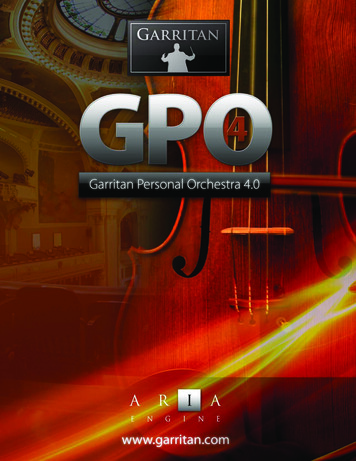
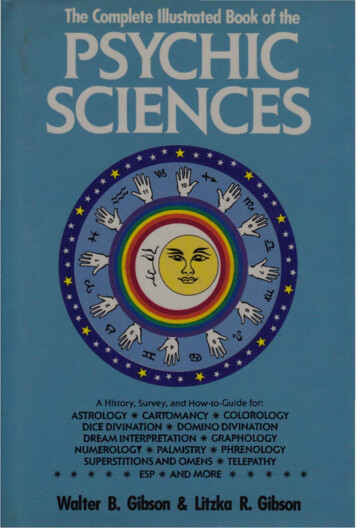

![Ewql Symphonic Orchestra Gold Full [PATCHED]](/img/66/talemm.jpg)
